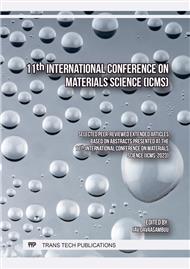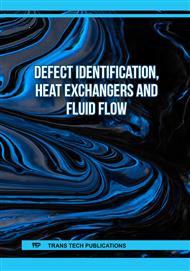[1]
Y. Pan, X. Hu, Y. Guo, X. Pan, F. Zhao, G. Weng, J. Tao, C. Zhao, J. Jiang, S. Chen, P. Yang, J. Chu, Vapor Transport Deposition of Highly Efficient Sb2(S,Se)3 Solar Cells via Controllable Orientation Growth, Adv. Funct. Mater. 31 (2021) 2101476.
DOI: 10.1002/adfm.202170204
Google Scholar
[2]
Z. Duan, Y. Feng, H. Ma, B. Liang, Y. Wang, S. Luo, S. Wang, Z. Li, Sb2Se3 Thin Film Solar Cells Exceeding 10% Power Conversion Efficiency Enabled by Injection Vapor Deposition (IVD) Technology, Adv. Mater. 34 (2022) 2202969.
DOI: 10.1002/adma.202202969
Google Scholar
[3]
Y. Lu, K. Li, X. Yang, S. Lu, S. Li, J. Zheng, L. Fu, C. Chen, J. Tang, HTL-Free Sb2(S,Se)3 Solar Cells with an Optimal Detailed Balance Band Gap, ACS Appl. Mater. Interfaces, 13 (2021) 46858−46865.
DOI: 10.1021/acsami.1c10758
Google Scholar
[4]
Z. Li, X. Liang, G. Li, H. Liu, H. Zhang, J. Guo, J. Chen, K. Shen, X. San, W. Yu, R.E.I. Schropp, Y. Mai, 9.2%-efficient core-shell structured antimony selenide nanorod array solar cells, Nat. Commun. 10 (2019) 125.
DOI: 10.1038/s41467-018-07903-6
Google Scholar
[5]
M. Luo,M. Leng,X. Liu,J. Chen,C. Chen,S. Qin,J. Tang, Thermal evaporation and characterization of superstrate CdS/Sb2Se3 solar cells, Appl. Phys. Lett. 104 (17) 173904-173904-4.
DOI: 10.1063/1.4874878
Google Scholar
[6]
X. Wen, C. Chen, S. Lu, K. Li, R. Kondrotas, Y. Zhao, W. Chen, L. Gao, C. Wang, J. Zhang, G. Niu, J. Tang, Vapor transport deposition of antimony selenide thin film solar cells with 7.6% efficiency, Nat. Commun. 9 (2018) 2179.
DOI: 10.1038/s41467-018-04634-6
Google Scholar
[7]
G.X. Liang, X.H. Zhang, H.L. Ma, J.G. Hu, B. Fan, Z.K. Luo, Z.H. Zheng, J.T. Luo, P. Fan, Facile preparation and enhanced photoelectrical performance of Sb2Se3 nano-rods by magnetron sputtering deposition, Sol. Energy Mater. Sol. Cells, 160 (2017) 257-262.
DOI: 10.1016/j.solmat.2016.10.042
Google Scholar
[8]
R. Tang, X. Wang, W. Lian, J. Huang, Q. Wei, M. Huang, Y. Yin, C. Jiang, S. Yang, G. Xing, S. Chen, C. Zhu, X. Hao, M. A. Green , T. Chen, Hydrothermal deposition of antimony selenosulfide thin films enables solar cells with 10% efficiency, Nat. Energy, 5 (2020) 587-595.
DOI: 10.1038/s41560-020-0652-3
Google Scholar
[9]
B. Krishnan, A. Arato, E. Cardenas, T.K. Das Roy, G.A. Castillo, On the structure, morphology, and optical properties of chemical bath deposited Sb2S3 thin films, Appl. Surf. Sci. 254 (2008) 3200–3206.
DOI: 10.1016/j.apsusc.2007.10.098
Google Scholar
[10]
Y. Zhou, M. Leng, Z. Xia, J. Zhong, H. Song, X. Liu, B. Yang, J. Zhang, J. Chen, K. Zhou, J. Han, Y. Cheng, J. Tang, Solution-Processed Antimony Selenide Heterojunction Solar Cells. Adv. Energy Mater. 4 (2014) 1301846.
DOI: 10.1002/aenm.201301846
Google Scholar
[11]
R. Krautmann, N. Spalatu, R. Gunder, D. Abou-Ras, T. Unold, S. Schorr, M. Krunks, I. Oja. Acik, Analysis of grain orientation and defects in Sb2Se3 solar cells fabricated by close-spaced sublimation. Sol. Energy, 225 (2021) 494-500.
DOI: 10.1016/j.solener.2021.07.022
Google Scholar
[12]
Y.C. Choi,T. N. Mandal W.S. Yang Y.H. Lee, S.H. Im, J.H. Noh, S.I. Seok, Sb2Se3‐Sensitized Inorganic–Organic Heterojunction Solar Cells Fabricated Using a Single‐Source Precursor. Angew. Chem. Int. Ed. 53 (2014) 1329-1333.
DOI: 10.1002/anie.201308331
Google Scholar
[13]
S.H. Wu, C.W. Chang, H.J. Chen, C.F. Shih, Y.Y. Wang , C.C. Li, S.W. Chan, High‐efficiency Cu2ZnSn(S,Se)4 solar cells fabricated through a low‐cost solution process and a two‐step heat treatment. Prog. Photovolt: Res. Appl. 25 (2017) 58-66.
DOI: 10.1002/pip.2810
Google Scholar
[14]
P Chin, C.S. Grant D.F. Ollis, Quantitative photocatalyzed soot oxidation on titanium dioxide. Appl. Catal. B- Environ. 87 (2009) 220-229.
DOI: 10.1016/j.apcatb.2008.09.020
Google Scholar
[15]
D.W. Zeng , B.L. Zhu , C.S. Xie, W.L. Song, A.H. Wang, Oxygen partial pressure effect on synthesis and characteristics of Sb2O3 nanoparticles. Mater. Sci. Eng A, 366 (2004) 332-337.
DOI: 10.1016/j.msea.2003.08.044
Google Scholar
[16]
Y. D. Luo, R. Tang, S. Chen, J.G. Hu, Y.K. Liu, Y.F. Li, X.S. Liu, Z.H. Zheng, Z.H. Su, X.F. Ma, P. Fan, X.H. Zhang, H.L. Ma, Z.G. Chen, G.X. Liang, An effective combination reaction involved with sputtered and selenized Sb precursors for efficient Sb2Se3 thin film solar cells. Chem. Eng. J. 393 (2020) 124599.
DOI: 10.1016/j.cej.2020.124599
Google Scholar
[17]
R. Mahani, E.A. El-Sayad, Effect of sulfur doping on the dielectric properties of Sb2Se3 system. J. Adv. Dielect. 9 (2018) 1950001-5.
DOI: 10.1142/s2010135x19500012
Google Scholar
[18]
N. Fleck, T. D. C. HOBSON, C.N. SAVORY, J. Buckeridge, T.D. Veal, M.R. Correia, D.O. Scanlon, K. Durose, F. Jäckel, Identifying raman modes of Sb2Se3 and their symmetries using angle-resolved polarised raman spectra. J. Mater. Chem. A, 8 (2020) 8337-8344.
DOI: 10.1039/d0ta01783c
Google Scholar
[19]
F Yakuphanoglu, M Sekerci, A Balaban, The effect of film thickness on the optical absorption edge and optical constants of the Cr(III) organic thin films. Opt. Mater. 27 (2005) 1369-1372.
DOI: 10.1016/j.optmat.2004.07.015
Google Scholar
[20]
F.D.B. Sánchez, M.T.S. Nair, P.K. Nair, Optimum chemical composition of antimony sulfide selenide for thin film solar cells. Appl. Surf. Sci. 454 (2018) 305-312.
DOI: 10.1016/j.apsusc.2018.05.076
Google Scholar
[21]
B.Yang, D.-J. Xue, M. Leng, J. Zhong, L. Wang, H. Song , Y. Zhou, J. Tang, Hydrazine solution processed Sb2S3, Sb2Se3 and Sb2(S1−xSex)3 film: molecular precursor identification, film fabrication and band gap tuning. Sci. Rep. 5 (2015) 10978.
DOI: 10.1038/srep10978
Google Scholar
[22]
L. Zhang, J. Qu, X. Kong, B. Liu, H. Yan, CIGS film from selenized of the electrodeposited CuIn alloy and CuGa oxide/hydroxide precursor. Appl. Phys. A, 127 (2021) 82.
DOI: 10.1007/s00339-021-04965-0
Google Scholar



